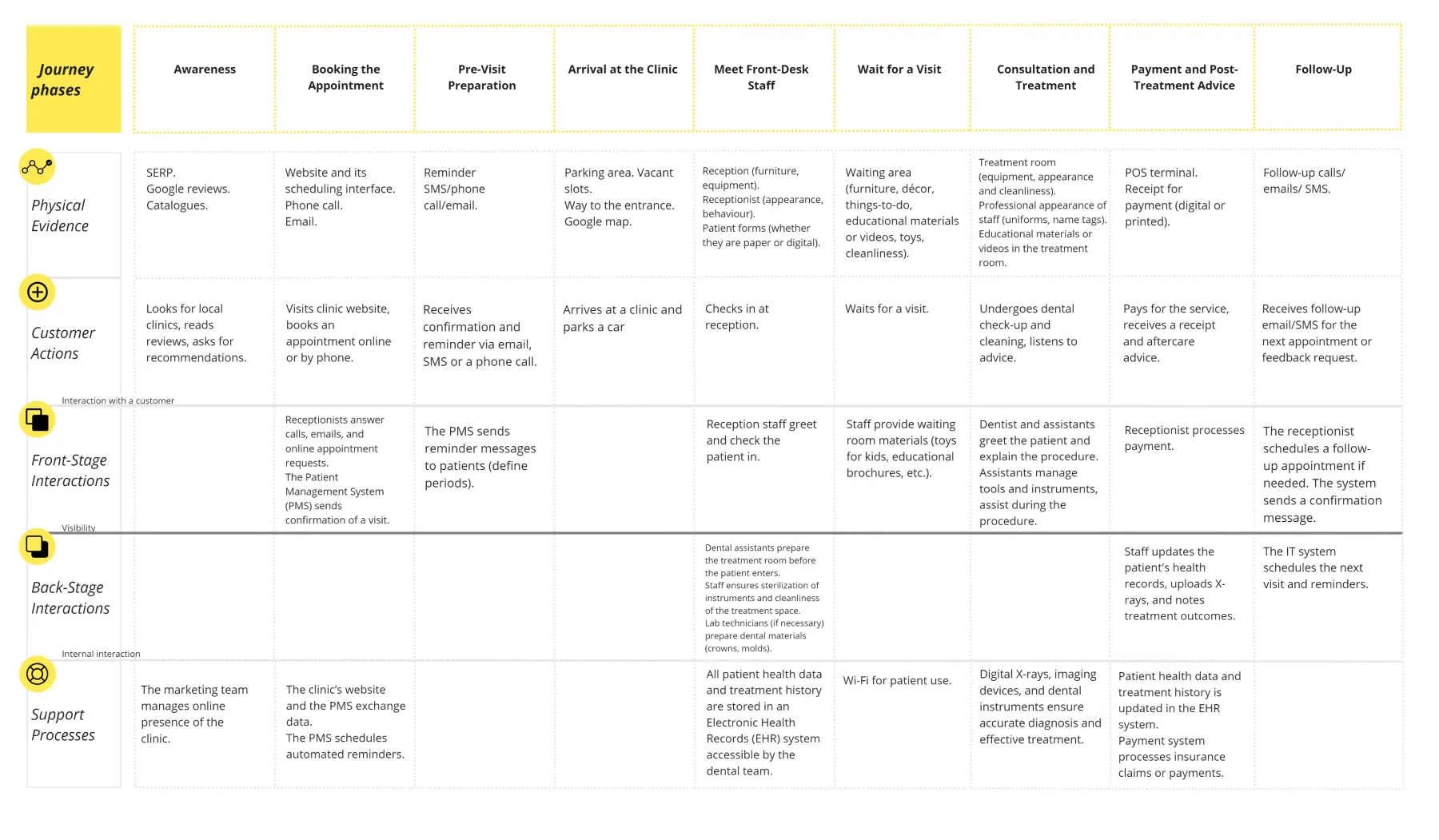
Dental clinics often focus on improving patient satisfaction. However, enhancing service design isn’t just about creating a better experience for patients — it also has a profound impact on employees and the clinic as a whole. In this part of the article, we’ll dive into how better service design can create meaningful benefits for both the team and the clinic.
In the previous part of the article, we explored how service design could enhance patient satisfaction, streamline operations, and foster lasting relationships with patients.
What is Service Design?
Service design refers to the planning and organisation of people, processes, and software and material components involved in delivering a service. The goal of service design is to create a smooth, coherent, and positive experience for both patients and staff, aligning operations with patient desires.
In a dental clinic, service design focuses on ensuring that every touchpoint in the patient’s journey — from awareness to follow-up — meets the needs and expectations of the patient. The key is to identify pain points in the service delivery and find innovative solutions to eliminate them.
You may read more about Service Design on our website.
Impact Of Service Design
If you ask employees of a dental clinic about the challenges they face in their work, they will likely mention the following:
- Hectic schedule
- High workload
- Dealing with difficult and anxious patients
- Inconsistent communication between dental assistants, hygienists, front desk staff, and dentists
- Adapting to new technology and procedures
Let’s explore how improving service design can create a more successful and harmonious dental clinic.
1. Collaboration and Cross-Disciplinary Work — Everyone is Important
One of the core principles of service design is co-creation. So collaboration inside the team starts during the service designing process itself, when on the stages of Concept development and Prototyping we involve team members to generate and refine ideas.
Let’s have a look on the journey map of a patient created for a dental clinic:
When working on the map, employees begin to realise that a patient's overall experience is made up of multiple touchpoints with the organisation, and failure to deliver quality service at any one of these can lead to disappointment. In this seamless chain, everyone plays a vital role. Recognising their own value and impact helps bridge gaps between receptionists, assistants, dentists, and other stakeholders, shifting their mindset from a purely operational focus to one that embraces collaboration, and empathy. This applies not only to patient-facing staff but also to those working behind the scenes, who are equally crucial to the clinic's success.
Service design further strengthens team collaboration during the implementation and delivery of services. It provides a framework for seamless cooperation, streamlines processes, and fosters a culture where employees are motivated to contribute to continuous improvement.
Order a Workshop
Designing a service is a long journey, but starting with a workshop is a great way to explore the benefits of service design without a major commitment.
We offer discovery workshops and focused sessions that allow you to identify key pain points, map out customer journeys, or prototype initial solutions.
Schedule a free consultation Schedule a free consultation2. Enhanced Satisfaction and Reduced Stress Through Clear Instructions and Streamlined Processes
A well-designed service structure makes the daily operations of the clinic smoother for employees. By focusing on service design, dental clinics can reduce employee stress and increase job satisfaction.
How This Helps Employees:
Clear Processes and Expectations: When a clinic has clearly defined procedures — from patient check-in to post-treatment follow-up — employees have a structured workflow. This reduces confusion, errors, and the need for constant problem-solving under pressure.
Employees no longer have to spend unnecessary time on manual tasks. For example, integrating an electronic health record (EHR) system reduces the time spent on paperwork and ensures that all team members have access to the same patient data in real-time.
Clear Role Definitions: In an efficiently run clinic, roles and responsibilities are clearly defined, which prevents overlapping duties and confusion. Each team member understands their tasks, making collaboration smoother and reducing workplace tensions.
Whereas a chaotic work environment can lead to burnout, especially for employees who must manage patient complaints or handle time-consuming administrative tasks.
How This Helps the Clinic:
Faster Patient Turnaround: Efficient workflows mean that patients move through the clinic more quickly and with less waiting time. This allows the clinic to serve more patients without sacrificing quality, boosting revenue.
Consistent Quality of Service: When employees work well together and know what’s expected of them, the clinic can provide a more consistent level of service. A unified team that functions efficiently is more likely to meet patient expectations, leading to higher satisfaction rates and positive reviews.
3. Improved Employee Satisfaction through Development
A clinic that continually evolves its service design offers opportunities for employees to learn new technologies, improve customer service skills, and be part of process improvements. Regular training in new systems or patient care techniques can empower employees and make them feel more valued in their roles.
How This Helps the Clinic:
Higher Employee Retention: Satisfied employees are more likely to stay with the clinic, reducing the costs associated with high turnover. Clinics that invest in improving the work environment see lower attrition rates, saving on recruitment and training costs.
Increased Productivity: When employees are less stressed and feel supported by a well-structured work environment, their productivity naturally increases. This leads to faster patient processing, fewer scheduling errors, and a more consistent quality of care, benefiting the clinic's overall performance.
Team Morale: In a well-designed service environment, employees experience fewer disruptions and more cooperation. A clinic that fosters good internal communication and collaboration will see higher team morale and a more pleasant work environment.
4. Increased Profitability and Operational Efficiency
Effective service design leads to increased profitability through better resource allocation, and reduced waste. A clinic that invests in designing its services carefully is more likely to see financial benefits in both the short and long term.
How This Helps Employees:
Job Security: When a clinic is financially successful due to operational efficiency, employees benefit from greater job security. Clinics that are profitable are more likely to offer competitive salaries, bonuses, and opportunities for advancement.
Career Growth: Financially stable clinics can invest more in their employees, offering continued education, certifications, and skill development programs. Employees benefit from greater opportunities for career growth and personal development.
Recognition and Incentives: Profitable clinics can introduce recognition programs and incentive schemes to reward high-performing staff. This motivates employees to continue providing excellent service while feeling valued by their employer.
How This Helps the Clinic:
Lower Costs: By automating tasks such as appointment reminders, billing, and patient management, clinics can reduce administrative overhead. For example, reducing paper-based processes not only saves time but also cuts material costs.
More Revenue Opportunities: Enhanced service design opens up additional revenue streams. For example, offering efficient follow-up services or preventive care packages encourages patients to book regular check-ups. Additionally, a smoother, more reliable system encourages more patient referrals and better online reviews.
Reduced Risk of Errors: Streamlined service processes reduce the likelihood of costly errors, such as double-booked appointments or insurance claims being mishandled. Reduced errors also mean fewer patient complaints, improving overall patient retention.
5. Better Patient Experience Leading to Positive Business Outcomes
While patient experience might seem to focus solely on customer satisfaction, a well-designed service model also directly impacts employees and the clinic’s bottom line. A smooth, positive patient experience reduces stress on employees and fosters a loyal patient base, which drives business growth.
How This Helps Employees:
Fewer Complaints: When patients are satisfied with their care, employees face fewer complaints and stressful situations. This creates a more positive work environment where employees can focus on patient care rather than conflict resolution.
Positive Work Environment: Happy patients contribute to a more uplifting atmosphere in the clinic. This encourages employees to take pride in their work and feel motivated to maintain high standards of care.
How This Helps the Clinic:
Higher Patient Retention: Satisfied patients are more likely to return for future appointments and recommend the clinic to others. This increases patient retention, which is more cost-effective than constantly acquiring new patients.
Strong Reputation: A well-designed service that consistently delivers positive patient experiences builds a strong reputation for the clinic. This can lead to higher referral rates, positive reviews, and increased brand loyalty — all of which boost the clinic's visibility and revenue.
Conclusion: Service Design as a Win-Win Strategy for Employees and the Clinic
Enhancing service design in a dental clinic is not just about improving patient care — it’s a holistic approach that benefits everyone involved. For employees, it creates a more structured, less stressful, and more rewarding work environment. For the clinic, it boosts operational efficiency, enhances teamwork, and drives profitability.
By focusing on service design, dental clinics can build a sustainable, thriving practice where employees are empowered, and the clinic achieves long-term success.


